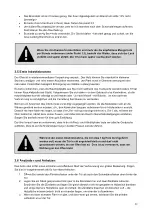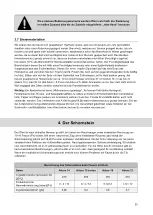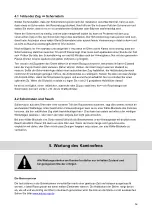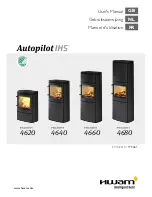
35
You should also be aware that the stove may make some clicking sounds as it heats up and cools down
–
like pouring boiling water into a sink. These are caused by the great differences in temperature to which the
materials are being exposed.
3.6 Lighting a fire in the wood burning stove
How you light a fire is very important for a quick and efficient ignition phase. Follow these instructions when
lighting the stove:
1. Open the primary damper under the door and the secondary damper behind the door.
2. Place a wood log crosswise in the combustion chamber and put 2 firelighters close to the log. Light
the firelighters and quickly put a new log close to the firelighters and several small logs at an angle
above it. Air must be able to reach the firelighte
rs, but the logs should be touching to “warm” each
other.
3. When there are distinct, visible flames and the fire is burning well, close the primary damper under
the door.
3.7 Recommended fuels
We recommend the use of split hardwood that has been stored outdoors under cover for at least 1 year.
Wood that has been stored indoors has a tendency to become too dry and will burn too quickly. We
recommend that you fell the wood during the winter when a lot of the moisture in the wood will have been
drawn down into the roots. In order to achieve optimum combustion, the wood’s moisture level should not
exceed 18%, which roughly corresponds to storing the wood outdoors under a cover for one year. The
moisture level of the wood can be measured using a wood moisture meter or by applying dishwashing liquid
to one end of the log and blowing air in the other end. If the wood is dry enough, soap bubbles will appear.
The wood should be chopped into logs with a diameter of approx. 10 cm and a length of max. 37 cm (Aduro
14) / max. 32 cm (Aduro 19) / max. 50 cm (Aduro 15 series & Aduro 21). Firing with wet fuel will reduce the
energy efficiency and increase the particle emission.
Burning varnished wood, impregnated wood, chipboard, paper, and other waste is strictly forbidden. Burning
these materials will damage the environment, the wood burning stove, and your own health. Fossil fuels
must not be used.
4. The chimney
The stove is tested in accordance with current standards, where a smoke exhauster secures a constant
chimney draft of 10-14 Pascal (Pa). However, with a natural draft (without a smoke exhauster installed) the
chimney draft will increase to 18-25 Pa at optimum conditions. There are many factors that affect the
During the first firing, which should be carried out using approximately 1 kg
of wood, the door must be left slightly open and must not be closed until the
stove is cold. This is to prevent the gaskets from sticking to the stove.
The control handles will get warm when the wood burning stove is in use.
Please use the glove provided when you operate the wood burning stove.
















































